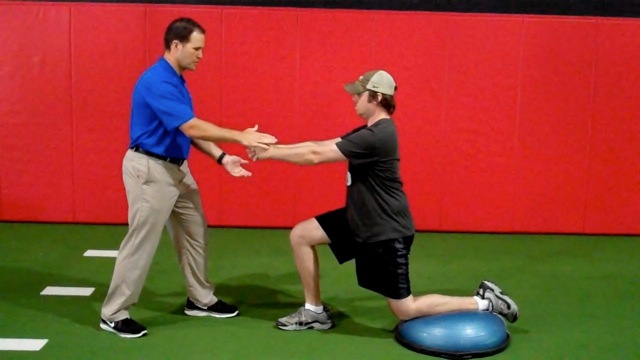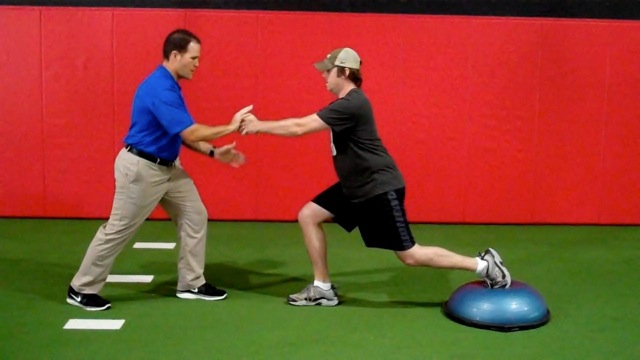
During training and rehab I often utilize split squats for strengthening. Beyond the impact on the lower extremity, I appreciate the need for sufficient trunk control and core stability necessitated by this exercise for injury prevention.
Invariably, I witness a deficiency in many clients manifested as too much forward or lateral trunk lean and excessive hip adduction/internal rotation) during split squats. I see this with the In-line Lunge on the FMS as well. Initially, I focus on isometric split squats on the floor to address this and then progress to active split squats once form is sufficient.
After this progression, I opt for increasing challenges to the core/trunk by reducing support and balance to the rear foot as well as adding external resistance to the isometric position in the form of light perturbations.
Execution:
Begin in a split squat position with the shin of the rear leg resting flat on the dome of the BOSU Balance Trainer. The front leg will be in 90 degrees of flexion with the trunk upright. Next, position the arms straight out in front of the chest (elbows extended and hands clasped together in 90 degrees of shoulder flexion).
The client is instructed to remain still while the trainer gradually applies resistance in multiple planes of motion (1-3 sec intervals) trying to disrupt the client's center of gravity. The goal is not to overpower the client, but more so to push right to the edge of his/her ability to resist the motion and maintain adequate control.
Perform multiple perturbations for 30 seconds at a time. Allow a 1:1 work to rest ratio and then switch legs. Repeat twice on each side. Be sure to provide cueing and feedback throughout so the appropriate motor learning takes place.
 |  |
Progression:
Once clients demonstrate good form and control, consider performing more random and rapid perturbations to further challenge the nervous system. The next progression is to place the rear foot on the dome of the BOSU Balance Trainer to further reduce the base of support. In this elevated rear foot position, clients will initially be able to tolerate very minimal force, so gage your perturbations carefully.
I suggest allowing them to practice isometric split squats without perturbations in this advanced position prior to adding resistance. This allows the trainer to coach alignment and cue appropriate muscle activation through careful observation in various positions relative to the client prior to participating in the exercise.
Note: Hip flexor tightness may be more apparent in the elevated rear foot position as more hip dissociation is necessary to remain upright compared to the shin down position. Additionally, clients will generally have more forward trunk inclination as they lean more forward to seek a position of greater stability.
Application:
Training the core and hips in a split squat stance is a very functional way to assess and improve a client's ability to maintain proper body alignment for activities such as running, cutting, jumping, etc. Keep in mind tight hip flexors and poor motor control may contribute to excessive forward trunk lean, while weakness in the lateral and spiral myofascial lines will dramatically limit control in the frontal and transverse planes.
You will also often see an overactive quadratus lumborum on the front side so it may be necessary to cue out of this pattern until the client understands the proper alignment and muscle activation patterns. Clients should be able to master split squats with perturbations on the floor prior to progressing to the version with the BOSU Balance Trainer.
The perturbations do not need to be significant to be effective, so grade them carefully as you work to train the desired neuromuscular patterns. If deemed too challenging bring the arms with the elbows at the side or simply provide perturbations to the trunk and shoulders.
Brian Schiff, PT, OCS, CSCS, is a licensed physical therapist, respected author and fitness professional. Currently, he serves as the supervisor at the Athletic Performance Center in Raleigh, NC. Brian presents nationally at several professional conferences and seminars on injury prevention, rehab and sport-specific training. For more cutting edge training information, subscribe to his monthly Training & Sports Medicine Update at www.BrianSchiff.com.
















